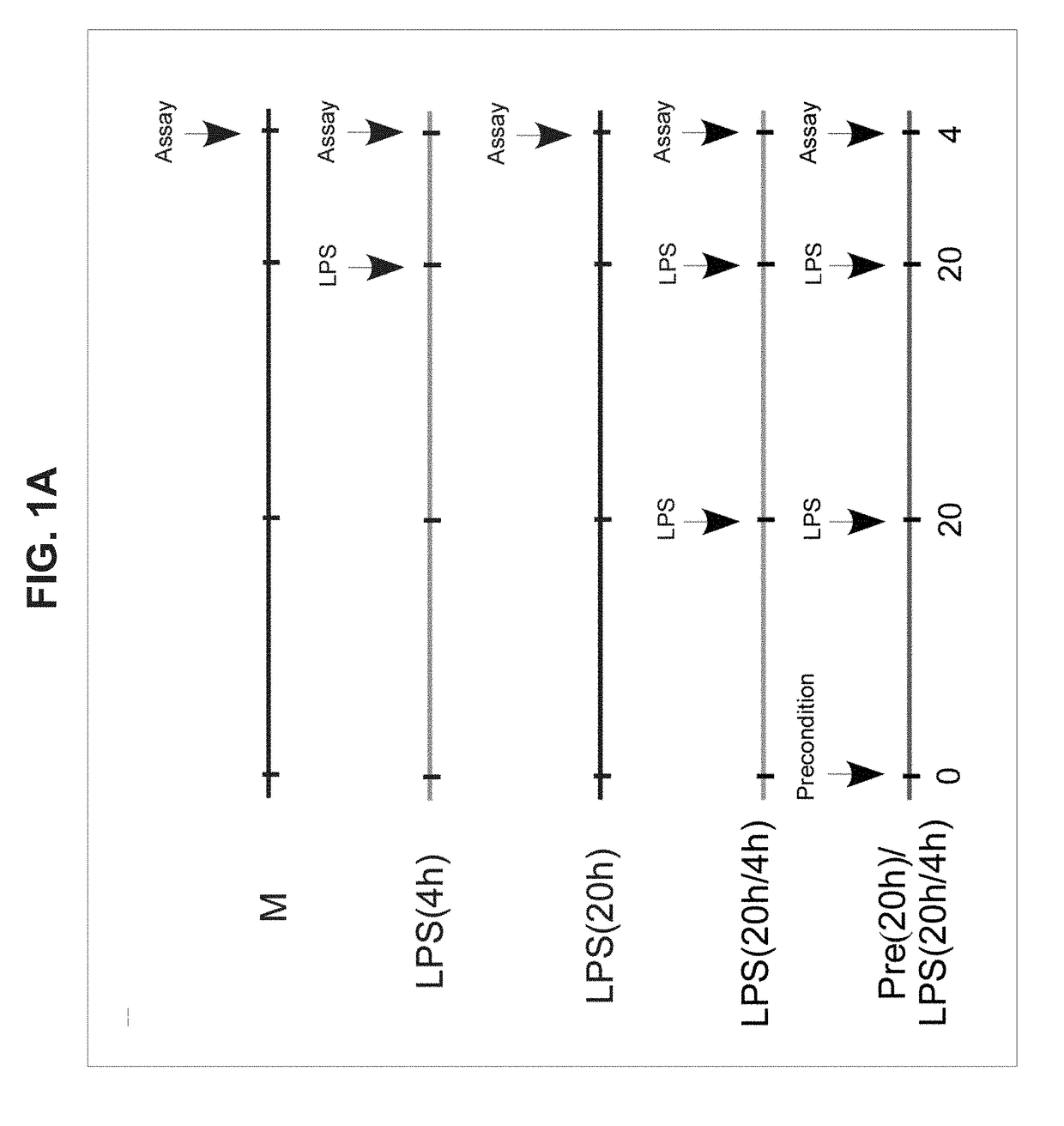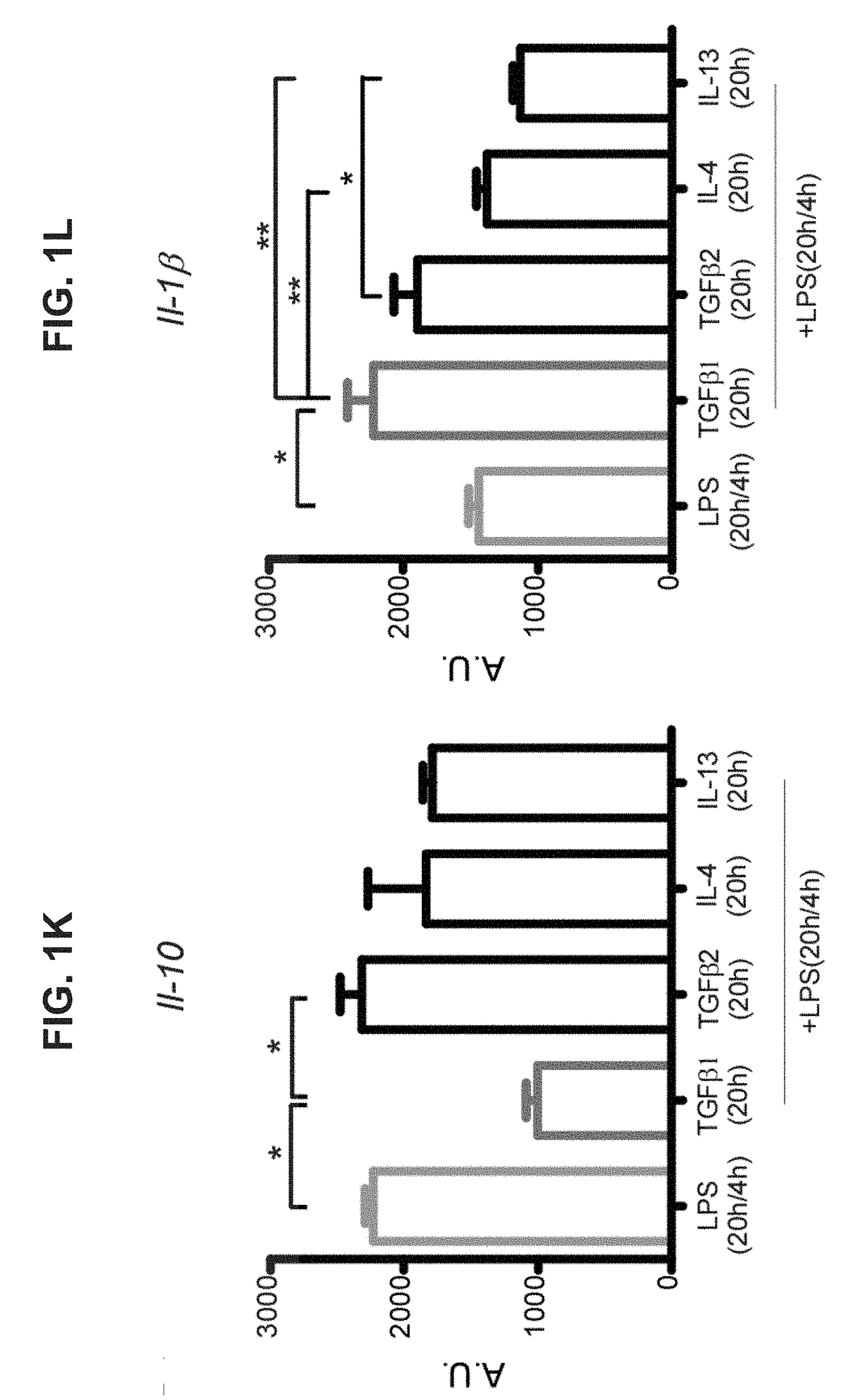Treatment of CNS inflammatory disorders
a technology for inflammatory disorders and central nervous system, applied in the field of central nervous system inflammatory disorders, can solve the problems of self-perpetuating local inflammation and tissue destruction beyond the primary insult, and achieve the effect of upregulating the anti-inflammatory respons
- Summary
- Abstract
- Description
- Claims
- Application Information
AI Technical Summary
Benefits of technology
Problems solved by technology
Method used
Image
Examples
example 1
M1-to-M2 Phenotype Switch of Newborn Microglia is Impaired by Long Exposure to TGF-β1
[0198]The present inventors' hypothesis was that although microglia differ in their origin from monocyte-derived macrophages (mo-MΦ), their response under pathological conditions within the central nervous system (CNS), is dictated to a large extent by their microenvironment. To test this hypothesis, the ability of newborn-derived microglia (NB-Mg) to undergo M1-to-M2 phenotype switch was first assessed. To this end, an established ex vivo model of macrophage polarization previously described by Porta [Porta C. et al., Proceedings of the National Academy of Sciences of the United States of America (2009) 106: 14978-14983] was adopted, in which M1 polarization, which is known to be induced by brief exposure to lipopolysaccharide (LPS, 4 hours), is inhibited as a result of extended LPS pre-exposure (20 hours). Under such conditions, the cells switch to an M2-like (anti-inflammatory) phenotype, and rem...
example 2
Long Exposure to TGF-β1 Activates a Robust Gene Expression Program in Myeloid Cells, with Implications to CNS Pathological Conditions
[0200]To understand the molecular events elicited by long exposure to TGF-β1, genome-wide expression profiles were measured using RNA-Seq of both BM-MΦ and NB-Mg along the time course of ex vivo TGF-β1 exposure. Globally, 2,721 and 642 genes showed expression changes (2 fold change; up or down) in response to TGF-β1 in BM-MΦ and NB-Mg, respectively (FIG. 2A). Notably, TGF-β1 induced a response that was similar in terms of gene expression pattern in both cell types, although they are of different developmental origin, BM vs. yolk sac, respectively (FIG. 2A). BM-MΦ exhibited higher responsiveness to TGF-β1 treatment compared to NB-Mg, reflected by the higher number of changed genes and the intensity of their change (p−5) (FIGS. 2B-C). The overall dynamic change of myeloid cell gene expression following long exposure to TGF-β1 revealed global effects of T...
example 3
The Transcription Factor IRF7 is Required for the M1-to-M2 Switch and is Suppressed by TGF-β1
[0203]In order to understand the mechanism underlying TGF-β1 impairment of the M1-to-M2 switch, the global gene expression data was further analyzed, seeking TFs whose expression was altered by the extended exposure to TGF-β1, and that were also involved in the M2 polarization in the previous LPS paradigm (FIG. 3A). The present inventors first focused on clusters I and XII (FIG. 3A) in which the TFs were expressed by both naive BM-MΦ and NB-Mg, and were similarly and significantly changed along the time course of TGF-β1 treatment. Among these TFs, several candidates were identified in cluster I: peroxisome proliferator-activated receptor γ (Pparγ), a member of the nuclear receptor family of transcription factors that mediates transcriptional activation of anti-inflammatory genes, and Interferon regulatory factor 7 (Irf7), an essential TF for antiviral immunity, whose involvement in the regul...
PUM
| Property | Measurement | Unit |
|---|---|---|
| thickness | aaaaa | aaaaa |
| size | aaaaa | aaaaa |
| pore size | aaaaa | aaaaa |
Abstract
Description
Claims
Application Information
 Login to View More
Login to View More - R&D
- Intellectual Property
- Life Sciences
- Materials
- Tech Scout
- Unparalleled Data Quality
- Higher Quality Content
- 60% Fewer Hallucinations
Browse by: Latest US Patents, China's latest patents, Technical Efficacy Thesaurus, Application Domain, Technology Topic, Popular Technical Reports.
© 2025 PatSnap. All rights reserved.Legal|Privacy policy|Modern Slavery Act Transparency Statement|Sitemap|About US| Contact US: help@patsnap.com



